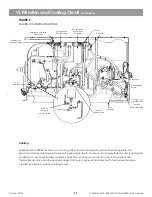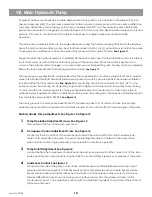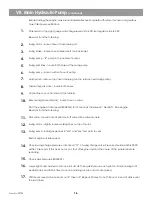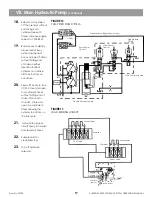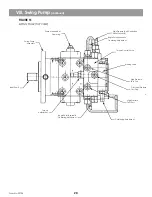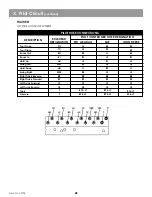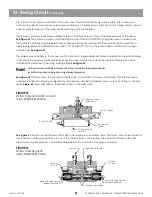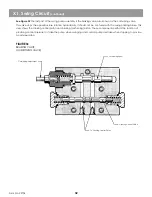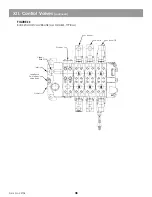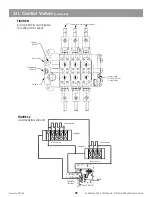
Form No. 29704
X. Pilot Circuit
(continued)
Pilot Circuit Solenoid Cut-Off Valve
Function:
Activated:
Location:
JOYSTICKS
GRADALL uses two types of Pilot Controllers. Two joysticks are used for the boom controls and two foot pedals are
used for the travel and steer functions (one each). Hydraulic fluid to the pressure ports comes from a 6.6 GPM pilot
pump. The pilot pump is in the rear section of the tandem gear pump behind the swing pump. Pilot pressure going
to the P port on the joysticks should be 480 PSI.
The two joysticks used for the boom functions are identical. They have six ports in the bottom of the housing and
are marked, P for pressure in, T for dump, and 1-4 for the ports going to the end caps of their respective main
control valve bodies. The joysticks can withstand 725 PSI and are rated for 4.8 GPM. The seals in the joysticks are
Buna-N.
See Figure 22, Figure 23 and Figure 24
All the spring packs are identical. When the hand lever is moved approximately four degrees, approximately 75 PSI
will be directed to the valve end caps. As the hand lever is progressively moved, the pressure should rise in a linear
fashion. At 19° and opproximatey 400 PSI the forced opening will be reached. The pressure will rise rapidly to pilot
pressure and metering capability will be greatly reduced. In the Neutral position, the operating lever is held at zero
degrees by the four return springs. When the lever is operated, the plunger is pushed against the return spring by
the cam plate. At the same time, the regulating spool is pushed through the regulating springs. This modulates
supply pressure from the P port to one or more of the four working ports, on to the valve end caps then to the
swing pump. It is important to remember that joysticks do not regulate flow, they regulate pressure.
FOOT PEDALS
GRADALL uses the same pedal valves for travel in the crawlers as well as the truck mounts. They are basically the
same as the joysticks, but only hove two pressure reducing valves instead of four. They ore protected from the
elements by rubber sleeves, stainless steel push rods and brass bushings. At rest, the foot pedal is held in its
Neutral position by two return springs. The two working ports are connected to the tank port. When the foot pedal
is depressed, the push rod is pressed against the large return spring as well as the inner control spring. The control
spring initially moves the control spool downward and closes the connection between the relevant working port and
the tank port. At the some time, the relevant working port is now connected to the pressure port that was dead
headed. Due to the interaction between the control spool and the control spring, the pressure in the relevant working
port is proportional to the stroke of the push rod and hence to the position of the pedal.
Stop pilot circuit fluid from reaching controls. When energized, all hydraulic circuits ore neutralized,
and will not engage·
By a switch connected to the operators sect right armrest. Whenever the armrest is raised the switch is
engaged and all circuit hydraulics are cut off. Pilot fluid returns to the reservoir.
Solenoid valve in main control valve compartment. Switch in electric circuit under right armrest of the
operators seat in upperstructure cab.
24
l
l
l
Summary of Contents for XL4000
Page 2: ......
Page 73: ......
Page 76: ... 5MP ...
Page 145: ......
Page 146: ......
Page 160: ......
Page 161: ......
Page 162: ......
Page 175: ......
Page 176: ......
Page 177: ......
Page 178: ......
Page 192: ......
Page 193: ......
Page 194: ......
Page 207: ......
Page 208: ......
Page 210: ...500P ...
Page 229: ......
Page 230: ......
Page 245: ......
Page 246: ......
Page 247: ......
Page 248: ......
Page 265: ......
Page 266: ......
Page 267: ......
Page 268: ......
Page 280: ......
Page 281: ......
Page 282: ......
Page 297: ......
Page 298: ......
Page 299: ......
Page 300: ......
Page 301: ......
Page 302: ......
Page 303: ......
Page 304: ......


